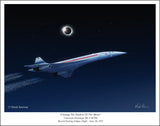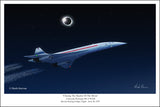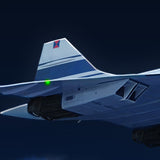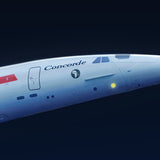The total solar eclipse of June 30,1973 presented a unique opportunity for astronomers at the time. Having first flown in 1969, the prototype Concorde supersonic transport had not yet entered service. It was realized the Mach 2 speed capabilities of Concorde would enable extended observation of the eclipse by scientists in flight.
Prototype Concorde 001 was specially outfitted with rooftop portholes and specialized equipment to study the solar corona. Taking off from Las Palmas on the island of Gran Canaria, Concorde 001 intercepted the path of the solar eclipse over North Africa. Flying at a speed of Mach 2.05 and at an altitude of 56,000 ft, the aircraft was able to remain in the shadow of the moon. Seven astronomers and physicists from France, Britain and the United States were able to continuously observe and record totality for 74 minutes. This flight set a record for the amount of time spent in totality that has never been broken.
Prototype Concorde 001 (F-WTSS) is on permanent exhibit at Le Bourget Air and Space Museum, complete with the special roof portholes and the eclipse mission logo on its fuselage.
Prototype Concorde 001 was specially outfitted with rooftop portholes and specialized equipment to study the solar corona. Taking off from Las Palmas on the island of Gran Canaria, Concorde 001 intercepted the path of the solar eclipse over North Africa. Flying at a speed of Mach 2.05 and at an altitude of 56,000 ft, the aircraft was able to remain in the shadow of the moon. Seven astronomers and physicists from France, Britain and the United States were able to continuously observe and record totality for 74 minutes. This flight set a record for the amount of time spent in totality that has never been broken.
Prototype Concorde 001 (F-WTSS) is on permanent exhibit at Le Bourget Air and Space Museum, complete with the special roof portholes and the eclipse mission logo on its fuselage.








